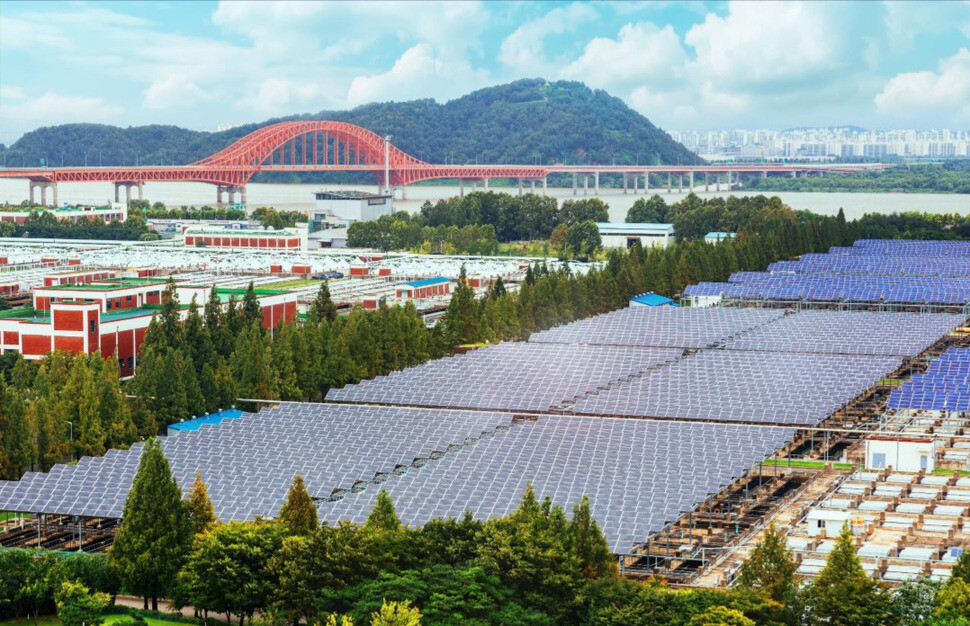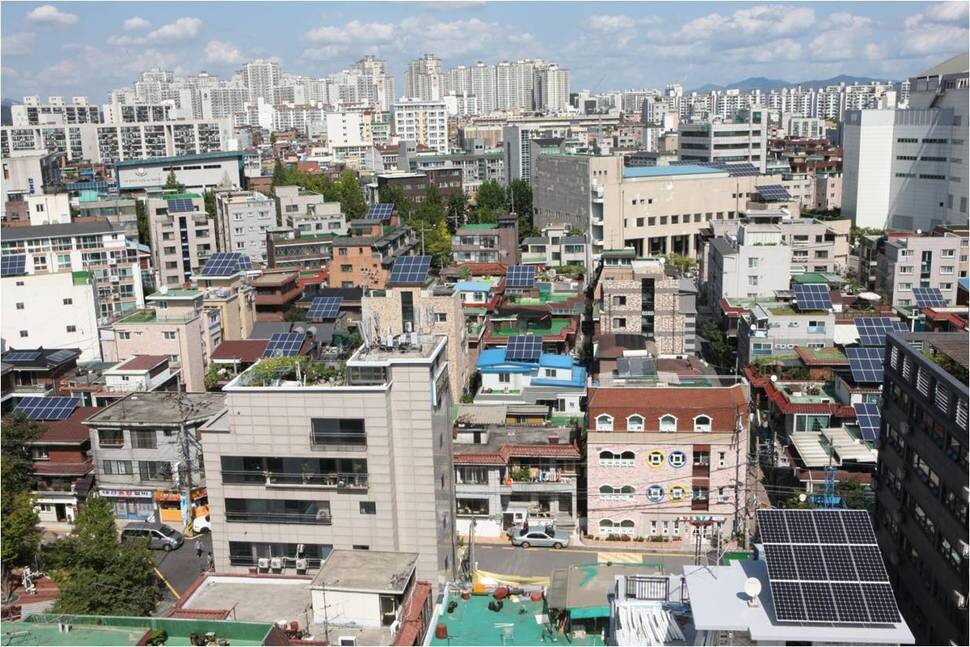hankyoreh
Links to other country sites 다른 나라 사이트 링크
“Solar City Seoul” aims to produce 1 GW of solar power annually

During the five years since 2012, the city of Seoul has replaced 3.66 million TOE (tonnes of oil equivalent) of energy through enrollment in its Eco-Mileage System and through enhancing buildings’ energy efficiency. That is the amount of energy produced annually by two nuclear reactors.
Whereas Seoul has previously been focused on reducing energy consumption, it is now shifting to energy production. It has now unveiled a master plan called “Solar City Seoul,” which aims to produce 1GW worth of solar energy – equivalent to the capacity of one nuclear reactor – during the five years through 2022.
The master plan will allocate a total of 1.7 trillion won (US$1.55 billion) over five years to seven initiatives, which are subdivided into 59 individual projects. The most striking feature of this plan is the initiative to increase the number of households with miniature solar generators installed on verandas and rooftops to 1 million.

Considering that there are currently only about 30,000 households with solar panels on their verandas, how could such a massive expansion be possible? “There were just 3,000 households with miniature generators in 2014, but that increased to 18,000 this year. If you combine that rate of increase in demand with the number of new apartments required to install panels by the Seoul Housing and Communities Corporation and with a distribution plan for each apartment complex, that number is achievable,” said Ahn Hyeong-jun, who is in charge of the city’s energy policy team.
At the moment, installing a 260W veranda generator at an apartment costs between 100,000 and 150,000 won (after city and local subsidies), which enables savings of about 5,600 won a month on average on the electricity bill. Rather than increasing subsidies, the city has resolved to have the Seoul Energy Corporation develop and distribute more affordable products. Supply could not keep up with demand for a program that subsidized the installation of solar panels on home rooftops, and though central government subsidies will end next year, the city of Seoul has decide to provide these subsidies on its own.
There is also a plan to install solar panels at Gwanghwamun Plaza, World Cup Park, Gwangjin Bridge and Magok District and to develop these areas either into solar energy landmarks or solar energy special districts.

Seoul’s development plan for solar energy isn’t just about distributing solar panels for home installation – it also means motivating ordinary people to participate in solar energy projects. “This plan is not about enriching KEPCO and other power companies but about expanding solar energy funds that ordinary people can get involved in. This can help people see that solar energy is helpful not only for the environment, but for the economy, too,” said Hwang Bo-yeon, chief of the city’s Climate and Environment Policy Department.
The first round of Seoul’s solar energy citizens’ fund, which was launched in 2015, was called early, with a 4% return on investment. For mid- and large-scale solar generation (around 1MW), the city will be harnessing a citizens’ fund in cooperation with financial companies; for small-scale generation (100kW) projects, it will promote a community fund that brings together highly profitable facilities and that even small-time investors can join.
“Since these projects are absolutely dependent on civic participation, we hope to see more policies for supporting energy cooperatives and specific plans for civic participation by next year,” said Choi Seung-guk, executive director of the Sun and Wind Energy Cooperative. In the initial phase, the city will be focusing on using schools and religious organizations such as Won Buddhism and the Catholic Church in its promotion and distribution efforts.
By Nam Eun-ju, staff reporter
Please direct questions or comments to [english@hani.co.kr]

Editorial・opinion
![[Column] Park Geun-hye déjà vu in Yoon Suk-yeol [Column] Park Geun-hye déjà vu in Yoon Suk-yeol](https://flexible.img.hani.co.kr/flexible/normal/500/300/imgdb/original/2024/0424/651713945113788.jpg) [Column] Park Geun-hye déjà vu in Yoon Suk-yeol
[Column] Park Geun-hye déjà vu in Yoon Suk-yeol![[Editorial] New weight of N. Korea’s nuclear threats makes dialogue all the more urgent [Editorial] New weight of N. Korea’s nuclear threats makes dialogue all the more urgent](https://flexible.img.hani.co.kr/flexible/normal/500/300/imgdb/original/2024/0424/7317139454662664.jpg) [Editorial] New weight of N. Korea’s nuclear threats makes dialogue all the more urgent
[Editorial] New weight of N. Korea’s nuclear threats makes dialogue all the more urgent- [Guest essay] The real reason Korea’s new right wants to dub Rhee a founding father
- [Column] ‘Choson’: Is it time we start referring to N. Korea in its own terms?
- [Editorial] Japan’s rewriting of history with Korea has gone too far
- [Column] The president’s questionable capacity for dialogue
- [Column] Are chaebol firms just pizza pies for families to divvy up as they please?
- [Column] Has Korea, too, crossed the Rubicon on China?
- [Correspondent’s column] In Japan’s alliance with US, echoes of its past alliances with UK
- [Editorial] Does Yoon think the Korean public is wrong?
Most viewed articles
- 1‘We must say no’: Seoul defense chief on Korean, USFK involvement in hypothetical Taiwan crisis
- 2N. Korean delegation’s trip to Iran shows how Pyongyang is leveraging ties with Moscow
- 346% of cases of violence against women in Korea perpetrated by intimate partner, study finds
- 4[Column] Park Geun-hye déjà vu in Yoon Suk-yeol
- 5‘Weddingflation’ breaks the bank for Korean couples-to-be
- 6Will NewJeans end up collateral damage in internal feud at K-pop juggernaut Hybe?
- 7Amnesty notes ‘erosion’ of freedom of expression in Korea in annual human rights report
- 8[Interview] Dear Korean men, It’s OK to admit you’re not always strong
- 9Korean government’s compromise plan for medical reform swiftly rejected by doctors
- 10[Editorial] Japan’s rewriting of history with Korea has gone too far